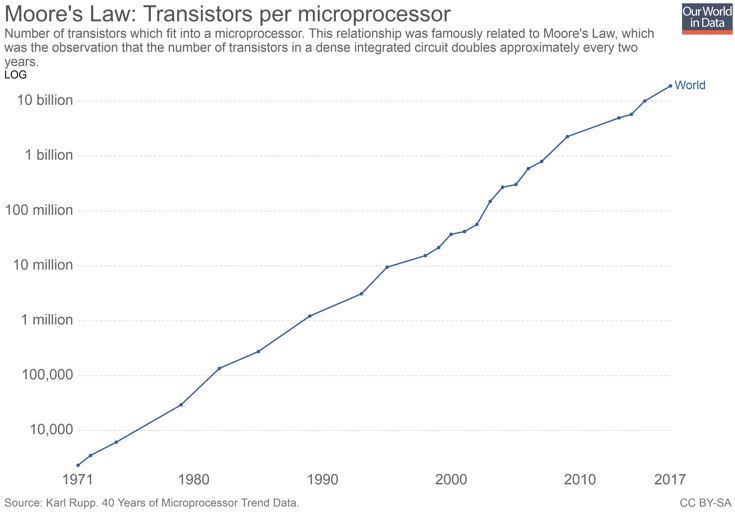If you want a quick, sustainable boost to sales and exposure, a solid growth marketing strategy is your best bet.
Big, established businesses typically have tons of cash to advertise all over TV, spend millions on online campaigns, and even take their brands into space, literally.
That’s how they get millions and billions of dollars in sales.
Even if you wanted to, your small business can’t do marketing like that.
You simply don’t have the resources or capital.
But, here’s the good news…
You don’t need to.
You can dramatically increase your sales without grand TV ads, splashing your name all over the Internet, or even taking your logo into space.
Besides, those bold mass media marketing ads are the least effective.
Check out how some of those methods rank in the chart below.
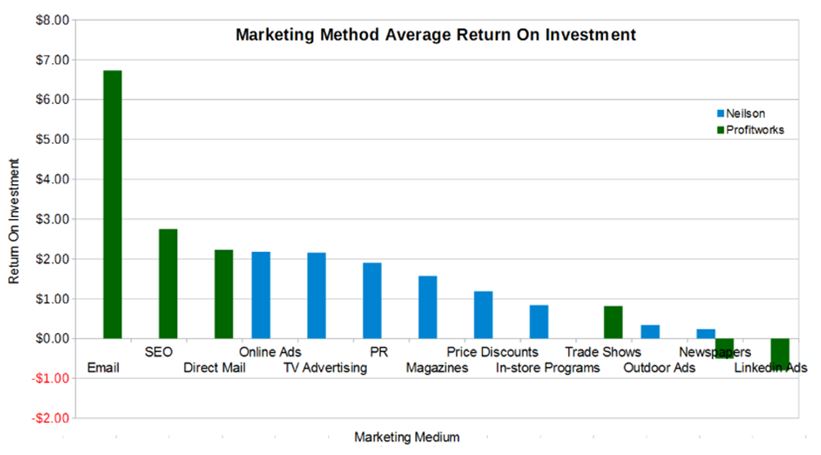
All you need to increase sales is cheap and effective growth marketing strategies.
That’s how to increase sales in a small business in a fast and sustainable way.
What is Growth Marketing?
Just as Facebook revolutionized the social media space and Google disrupted the search engine industry, growth marketing is overhauling traditional marketing.
Traditional marketing is dumb.
There’s simply no other way to put it.
Growth marketing is smart.
Essentially, growth marketing is a system of continuously enhancing your marketing strategies based on data, to produce robust and sustainable growth.
It complements traditional marketing methods with optimization features, A/B testing, data analysis, technical analysis and a large dose of creativity.
It’s more than mere growth hacking.
Growth hacking offers fast and creative solutions for challenges in business.
Growth marketing not only provides fast and creative solutions but, most importantly, takes a sustainable long-term approach.
Why Growth Marketing Has Gained Popularity
The age-old question, “How to increase sales in a small business?” contributed to the origin of growth marketing.
The concept has probably been around for a long time.
However, the origin of the term “growth marketing” can be traced to Eric Ries’ 2011 book, The Lean Startup.
The book focuses on being hyper-efficient with resources in order to profit and succeed in business.
The book clearly struck a chord with entrepreneurs, having come after the recession, when more businesses “died” than were “born” (as seen in the following chart).

That simple graph of historical trends of “births” and “deaths” of businesses in the US is one of the main reasons why growth marketing has gained popularity.
Since 1993, more and more businesses are starting up.
This creates the necessity to fight off competition; otherwise, you end up among the businesses closing shop every year.
Besides the competition, businesses also have to deal with environmental conditions like recessions.
Clearly, the normal way of doing businesses increases your chances of becoming on of the statistics.
Hence, the need for unconventional thinking in order to increase sales and stay in front of your competition.
That’s where a growth marketing strategy becomes super valuable.
Look at what the majority of people are doing and do the exact opposite, and you'll probably never go wrong for as long as you live. -Earl Nightingale Share on XBesides, we can’t ignore the incredible impact of technology on marketing today.
The two charts below show why growth marketers typically leverage technology for incredibly efficient and highly effective growth marketing strategies.
This first chart shows the exponential increase in computing power over the years.
This second chart shows the exponential increase in computing efficiency.
What this means is that super advanced, yet super efficient technology can produce far greater bang for your buck in marketing.
And it’s not just start-ups like Big Drop and Stride Health that are implementing growth marketing.
Even established firms like Zynga are hiring growth marketers to run their campaigns.
What Makes Growth Marketing Different?
One thing that makes growth marketing different (and exciting) is that it can leverage small numbers of prospects to produce a larger number of conversions.
Ordinarily, you would get a small number of conversions after reaching out to a large pool of prospects.
Ideally, the reverse happens with growth marketing.
In a sense, the growth marketing campaign “grows” organically.
At the end of the day, you want more conversions for your business, not just more people seeing your message.
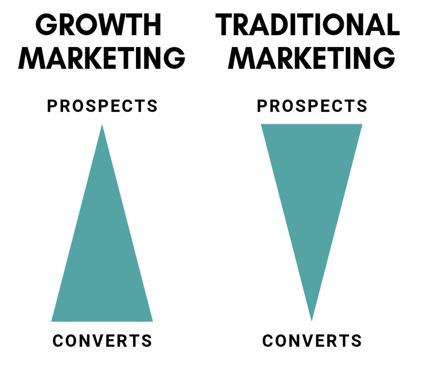
So how does that happen?
Well, growth marketing isn’t only focused on Above-the-Line marketing.
Not only does it cater to awareness and acquisition (i.e. brand awareness), but it also engages and retains users, and even turns them into raving fans for the brand.
Continuous, data-driven and experimental strategies are applied at every stage of the marketing funnel:
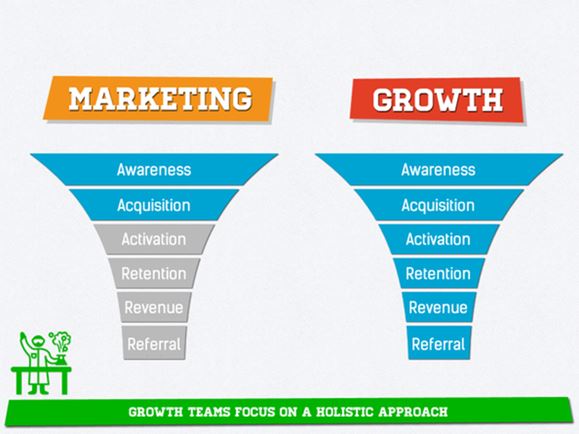
Keep in mind, growth marketing does bear some similarities to certain forms of marketing, including:
- Closed loop marketing
- Computational and data driven marketing
- Concentrated marketing
- Guerrilla marketing
- Marketing focues on user engagement
- Interactive marketing
- Brand and loyalty awareness
- Multi-level marketing
- Affiliate marketing
- Scientific marketing
Considering that growth marketing is a holistic marketing strategy, it incorporates multiple approaches to the marketing system.
It features characteristics from a long list of strategies including business to business (b2b) strategies, conversion rate optimization, pay-per-click, referral and relationship marketing, permission based marketing, and influencer marketing to name a few.
How to Succeed as a Growth Marketing Manager or Owner
If you’re wondering about how to increase sales in your small business, you probably can’t afford to hire a growth manager.
That means, you – the business owner – are the default growth manager.
To succeed, you must have specific characteristics and understand your responsibilities.
1. Characteristics of a Growth Marketing Manager
Growth marketing skills are largely the typical marketing skills, but taken to another level.
Here are some of the qualities of successful growth marketers.
You should be data driven, but detail oriented and capable of detecting insights that are not obvious.
For example, you might assume that getting more employees to serve greater demand for your product is beneficial, but the increased profitability may actually be a loss, based on the law of diminishing marginal returns.
Creativity, bordering on craziness, is a key ingredient too.
People thought Airbnb was crazy to provide free professional photography to every home owner listed on their site.
Far from crazy, it ignited amazing growth for the company.
You should also have a near-obsessive product focus.
The more you know about the features, benefits, and potential uses of your product, the better you can position it in the market.
In the early days of the internet, when leading search engines like Yahoo were comfortable providing a low quality search engine, two guys with some vision and an obsession for the product (Sergey Brin and Larry Page), came along and created a better product.
We now know that product as Google and I think those guys are worth about 50 billion each!
Also, as your own growth marketing manager, you’ll be a jack of all trades.
Due to the unconventional nature of growth marketing, any sort of task can drop on your table.
You need to be ready for that.
If it’s an opportunity guaranteed to produce great results, you wouldn’t just dismiss it because you don’t have the skill.
More than likely you’ll go try to learn how to take advantage of the opportunity.
Most of all, if you want to succeed in growth marketing, you absolutely must learn to leverage your failure.
You’ll have lots of failures.
Those failures can be the biggest opportunities in disguise.
That’s how a failed experiment produced the Post-it Notes runaway success story.
On top of all those exciting skills, you also need to develop a few other skills as you go.
I call these the “boring but necessary” skills:
- People skills
- Project management skills
- Organizational skills
- Communication skills
- Ability to use software applications
- Problem solving skills
- Strategic planning skills
- Leadership capacity
2. Responsibilities of a Growth Marketing Manager
To succeed in growth marketing, either for your own small business or to help others, you must observe a day-to-day schedule of executing specific tasks.
Here’s a sample of the tasks you’ll be involved in:
- Working with diverse teams from sales people, back-office staff, to mangers.
- Creating, managing and experimenting with user acquisition campaigns.
- Conceiving and executing diverse content campaigns for engagement and education.
- Managing varied social media platforms, like Twitter, Facebook, Instagram, and YouTube.
- Managing SEO.
- Analyzing data to assess performance and uncovering areas that need improvement.
- Preparing, and presenting findings, reports and recommendations.
- Identifying target segmentations.
- Developing test plans.
- Partnering with local and international teams.

Many of these tasks can be managed through multiple tools such as:
- Leadpages (building customized landing pages)
- Adroll (tracking site visitors through ads)
- Sumo (lead capturing and increasing conversions)
- Ahrefs (building keyword lists and SEO)
- Proof (increasing conversions using social proof)
- Buzzsumo (analyzing top performing content)
- Voila Norbert (finding emails)
- Amplitude (improving products)
- Apptimize (A/B testing mobile apps)
- …and many more.
Best of all, you can streamline and automate most of the “boring” stuff using a tool like Zapier, which connects multiple apps together.
The Growth Marketing Process
The growth marketing process isn’t linear like traditional marketing.
All the steps are interrelated.
This is what makes it super efficient and so effective that it can produce exponential results.
This can translate to an increase in sales like you’ve never experienced!
Here’s how the steps are interrelated.
Step 1: Acquisition
The basic goal of acquisition is to boost traffic numbers.
Growth marketing focuses on the least cost per acquisition.
This can involve passive, continuous organic traffic acquisition through SEO, rather than short-term active paid ads or social media.
Besides you actively getting prospects, you can get referral traffic through growth marketing strategies.
With the right incentives, your existing converts or prospects can share and talk about your products, pulling in more traffic.
Step 2: Conversion
The key goal of this step is to increase conversion rates.
This step has a dramatic impact on acquisition costs.
For instance, optimizing landing pages for conversion will produce more buyers without needing to acquire more traffic.
HubSpot did this with their website design and doubled their conversion rates.
Step 3: Engagement
Engagement further impacts conversion rates.
By engaging your prospects more, you build trust.
This makes them more likely to buy.
It may seem like more work to engage your prospects, but it’s certainly costlier to get more prospects instead of selling to those you already have.
Getting new customers could cost you five times more than keeping your existing customers happy.
Step 4: Revenue
Just making a sale isn’t enough.
You also need to increase the average order value and lifetime value of each customer.
This is only be possible if you continually engage your prospects and existing customers.
When you’re constantly in touch and engaged with them, guess what? You’ll be the business they buy from again and again.
Moreover, constant engagement enables you to analyze your customers’ behavior in order to improve and better position your products or services.
Step 5: Referral
This may be the last step, but it’s a vital step to keep your business going.
An effective referral system literally shaves hundreds, thousands, or millions of dollars off of your marketing budget.
The combined, viral effect of multiple referrers will constantly pull more traffic, conversions, engagement and revenue.
As technology has merged with our daily lives, this is one reason network marketing is gaining in popularity and people are choosing it as a viable career option.
The 5 steps below (when implemented correctly) become the blueprint of how to increase sales in a small business (regardless of what niche you’re in).
Smart Growth Marketing Strategies
This all seems theoretical, so let me give you some practical tactics that will increase sales and your bottom line.
Below are some actionable examples of growth marketing strategies for small businesses.
Try them out and see how they work:
1) Use exit intent to grow your email subscribers
You might think all hope of converting a prospect is gone at the point when they are about to leave your site.
But you’ll be surprised at just how many email subscribers you can pull in if you use that action as a trigger to subscribe to your newsletter.
2) Get a referral just before they buy
Conventional wisdom says that you shouldn’t distract someone who is buying.
But that’s where conventional wisdom ends and growth marketing begins.
If the buyer’s action of putting a product in a shopping cart triggers an offer to reward them with a discount for sharing the product, you’ll kill two birds with one stone.
3) Apply incentives at multiple user levels
One concept behind network marketing success is the continuous system of incentives for multiple user levels.
Virtually every action users take is tied to some sort of incentive.
You don’t have to make it a financial incentive either.
You can simply gamify the process (I’ll discuss this in a minute) or embed competition into the environment.
4) Make incentives more valuable at “zero” cost
The challenge with incentives is that they cost money.
But you can make them more valuable simply by making them more urgent and exclusive to specific prospects, as well as other tactics.
For instance, adding a countdown timer with a freebie when you order adds value AND urgency.
5) Make selling enjoyable for your staff
The importance of effective communication in business organizations should never be underestimated.
If your team isn’t aligned to your goals and objectives, you’ll hardly succeed in your marketing efforts.
But communication is boring; especially those board room meetings that don’t achieve much.
Fortunately, you can get your team excited about your business objectives by gamifying the selling process.
There are a few tools out there you can use for that.
6) Use social ads
Compared to many types of advertising, social ads are dirt cheap:
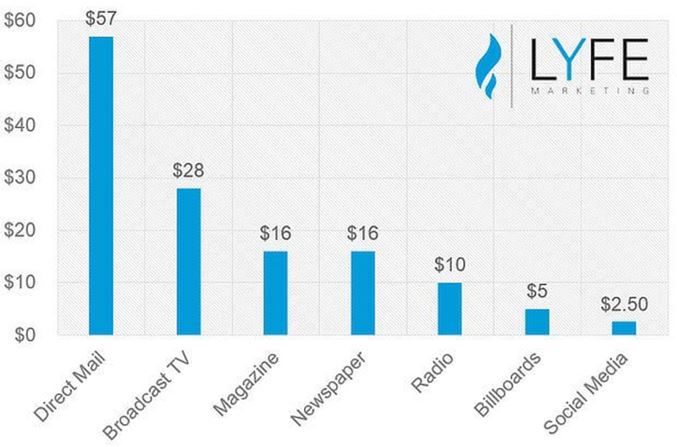
Did you know that PostPlanner’s Scott Ayres spent a mere $20 to boost a social media post and made sales worth $2,400.
That’s one way (of many) to flip money for profit.
Conclusion
As you develop your own unique growth marketing strategies, you can borrow ideas and learn from successful growth marketers like Brian Balfour, Danielle Morrill, Neil Patel, and Anum Hussain.
Have you tried any growth marketing strategies?
If so, share in the comments what’s working for you and what’s not.
Until next time, God Bless and I hope you’re building the life of your dreams.
Please reach out to us if you’d like to work with us on our current project.
Lastly, the most important decision of your life isn’t whether to implement growth marketing tactics, it’s actually the decision of who you will serve and how you will spend eternity.

Jason & Daniele

